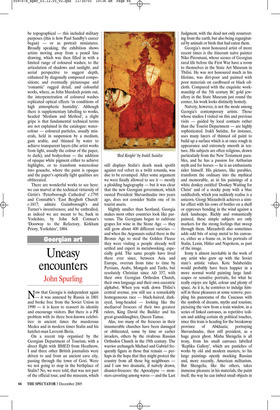A very British medium
Angela Summerfield
The Elemental North Messum’s, 8 Cork Street, London IY1, until 3 December Gainsborough to Turner: British Watercolours from the Spooner Collection Hermitage Rooms, Somerset House, until 12 February 2006
Watercolour, that quintessentially British medium and form of expression, is currently enjoying a revival of interest among contemporary artists and academics alike. Following on from Tate Britain’s riveting Thomas Girtin exhibition and Hockney’s forays into the Nordic and Yorkshire landscapes come two exciting and enchanting shows, a short bus journey between the two. Both offer a rare opportunity to see in London otherwise inaccessible works.
At Messum’s, the show of north Yorkshire artists includes small-scale atmospheric watercolours and mixedmedia works, of the dales, by Peter Hicks. In Len Tabner’s smalland large-scale works, one can see how the thick handmade paper has been flooded with watercolour to create dramatic tensions, as the watercolour, wet on wet, is manipulated in unison with opaque materials, such as chalk, pastel and pencil. As the catalogue author, Jenny Pery, states, such works as ‘Whitby from Upgang Shore, April 12th 2005’ represent a ‘passionate account of one man’s experience of the watery, earthy, fiery and airy elements with which we are all surrounded’. In marked contrast are the colourful abstract watercolours by William Tillyer. These explore the wonderful range of watercolour’s pellucid possibilities: transparent layers of infinite depth and variety — as Thomas Girtin was the first to discover; large areas of seemingly arm-length action which pour, spill and spin across and into the special Arches paper’s surface.
We can discover the original uses, investigations and experimentations of watercolour at the Hermitage Rooms. The hang, deliberately designed so as to enhance the sense of a domestic atmosphere, is arranged thematically: Antiquity and Ruins; Artists Abroad; Seascapes and Figures; Landscape and Nature; Trees and Woodland. On display is, for the first time, largely the entire collection of 18thand 19th-century British watercolours, formed by William Wycliffe Spooner and his wife Mercie, and bequeathed to the Courtauld Institute of Art in 1967; the Courtauld will shortly be opening a prints and drawings room, so as to make its seminal and formerly study collections accessible to the public, as well as offering images on-line.
The 80 works on display cover the socalled Golden Age of British watercolour painting, that is, c.1750–1850; Turner died in 1851. More than 50 artists are represented: these include John Constable, John Sell Cotman, Alexander and John Robert Cozens, Peter De Wint, Thomas Gainsborough, Thomas Girtin, Edward Lear, Mary Moser, Samuel Palmer, Thomas Rowlandson, Paul Sandby, Francis Towne and J.M.W. Turner. The exhibition seeks to challenge the received history of British watercolour practice, and therefore a number of ‘lesser-known but highly competent drawing masters, journeymen professionals and inspired amateurs’ are also included alongside contemporary painting tools and devices. Rather than being generated on the spot, the scholar Greg Smith argues in a fascinating catalogue essay, what we are often seeing are different types and stages of ‘hybrid works’, where the role of memory, annotated notes, pencil line sketches and the studio all played a part. Some works were ‘completed’ to generate commissions, or as exhibitable works in their own right, but artists’ claims of authenticity were sometimes open to question. Many artists turned to teaching, publishing their own theories and drawing manuals: Alexander Cozens developed a blot technique to kickstart ideas for compositions, and his ‘A Blasted Tree in a Landscape’ c.1780 is both an archetypal image of the age of the sublime and picturesque, and personal symbolism.
Originally, watercolour was restricted to recording a descriptive likeness, whether it be topographical — this included military purposes (this is how Paul Sandby’s career began) — or as portrait miniatures. Broadly speaking, the exhibition shows artists moving away from a pencil line drawing, which was then filled in with a limited range of coloured washes; to the articulation of shadows and sunlight, and aerial perspective to suggest depth, enhanced by diagonally composed compositions; and eventually picturesque and ‘romantic’ rugged detail, and colourful works, where, as John Murdoch points out, the interpenetration of coloured washes replicated optical effects ‘in conditions of high atmospheric humidity’. Although there is supplementary labelling to works, headed ‘Medium and Method’, a slight gripe is that fundamental technical terms are not explained in the catalogue: watercolour — coloured particles, usually minerals, held in suspension by a medium, gum arabic, and thinned by water to achieve transparent layers (the artist works from light, usually the colour of the paper, to dark); and bodycolour — the addition of opaque white pigment either to achieve highlights, or to transform watercolour into gouache, where the paint is opaque and the paper’s optically light qualities are obliterated.
There are wonderful works to see here: we can marvel at the technical virtuosity of Girtin’s ‘Peterborough Cathedral’ c.1795 and Constable’s ‘East Bergholt Church’ c.1817; admire Gainsborough’s and Turner’s inventiveness; and be enthralled, as indeed we are meant to be, back in Yorkshire, by John Sell Cotman’s ‘Doorway to the Refectory, Kirkham Priory, Yorkshire’, 1804.




























































 Previous page
Previous page